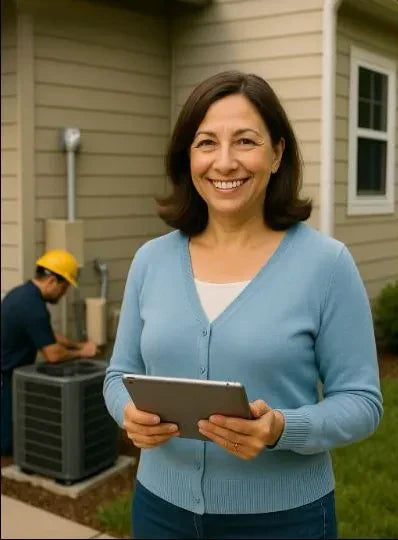Signs Your HVAC System Is Costing You: When It’s Time to Upgrade
Your home’s HVAC system — whether it’s a furnace, air conditioner, or a combined unit — is one of the most important investments you’ll make for comfort and efficiency. But over time, even the best systems can start to cost more than they save. Higher energy bills, inconsistent heating or cooling, and frequent repairs are all red flags that your system may be aging or inefficient.
In this guide, we’ll cover the most common signs that your HVAC system is costing you, explain why upgrades are often worth the investment, and provide tips on how to maximize comfort while reducing energy bills.
🔥 Sign 1: Rising Energy Bills
One of the first signs that your HVAC system is underperforming is a steady increase in energy bills. Even if your usage hasn’t changed, an older or poorly maintained system can consume more energy to provide the same level of comfort.
Why It Happens:
-
Components like compressors, fans, or heat exchangers lose efficiency over time.
-
Clogged filters or dirty coils make your system work harder.
Example:
A 12-year-old air conditioner can use up to 30% more electricity than a newer, energy-efficient model with a high SEER2 rating.
🔗 U.S. Department of Energy: Tips to Reduce Energy Bills
⚡ Sign 2: Inconsistent Temperatures
Rooms that are too hot or cold, or noticeable temperature swings, indicate your system isn’t distributing air properly.
Common Causes:
-
Uneven airflow from leaky ducts.
-
Aging furnace or AC components failing to maintain set temperatures.
-
Poorly sized units for your home’s square footage.
Regular maintenance can sometimes fix minor issues, but if the system is old, replacement may be the only long-term solution.
🔗 DOE: Common Air Conditioner Problems
🏠 Sign 3: Frequent Repairs
Frequent breakdowns and repair calls are a sure sign your system is costing you more than it should.
Cost Impact:
-
Older units may require $200–$500 per repair, sometimes multiple times a year.
-
Replacement parts for outdated models may be expensive or hard to find.
When repair costs start to approach 50% of a new system’s cost, it’s usually more economical to invest in a new HVAC system.
🔗 Energy.gov: Repair vs. Replace HVAC
❄️ Sign 4: Poor Air Quality
If your home has increased dust, mold, or allergens, your HVAC system may be struggling to circulate clean air efficiently.
Why It Matters:
-
Aging air filters or ducts can harbor dust, mold, and bacteria.
-
Poor ventilation reduces overall air quality and can impact health.
Upgrading to newer systems with better filtration or UV light options can improve air quality significantly.
🔗 EPA: Indoor Air Quality and HVAC Systems
🌡 Sign 5: Strange Noises or Odors
Unusual sounds (clanging, rattling, or hissing) or foul odors from your system may indicate worn components, refrigerant leaks, or mold growth in ducts. Ignoring these signs can lead to bigger problems, including costly repairs or even safety hazards.
⚙️ Sign 6: Your System Is Over 10–15 Years Old
Most HVAC systems have a lifespan of about 12–15 years. If your system is approaching or exceeding this range, it’s more likely to:
-
Use more energy than modern units.
-
Require frequent repairs.
-
Fail to maintain comfortable temperatures.
Even if it’s still running, older systems may not meet current furnace efficiency standards, meaning you’re overpaying on utility bills.
💡 Benefits of Upgrading Your HVAC System
-
Lower Energy Bills: Modern units with high SEER2 and AFUE ratings use significantly less energy.
-
Improved Comfort: Better temperature regulation and airflow.
-
Enhanced Air Quality: Advanced filtration and ventilation systems reduce allergens and pollutants.
-
Fewer Repairs: Newer systems are less likely to break down, saving money on maintenance.
-
Rebates and Incentives: Many energy-efficient units qualify for state or federal rebates.
🏡 Real-Life Homeowner Scenarios
Case 1: The Rising Bill Dilemma
Samantha noticed her winter heating bills were increasing year after year, despite minimal usage. After installing a new high-efficiency gas furnace and pairing it with a SEER2-rated air conditioner using R-32 refrigerant, she reduced her annual energy bills by 25%.
Case 2: The Cold Room Problem
Mark’s upstairs bedrooms were consistently colder than the main floor. A professional inspection revealed leaky ducts and an undersized furnace. After replacing the old system and sealing the ducts, he achieved even temperatures throughout his home.
⚙️ Choosing the Right Replacement
When upgrading, consider:
-
System Type: Air conditioners, gas furnaces, heat pumps, or combination units.
-
Efficiency Ratings: Look for SEER2 (AC) and AFUE (furnace) ratings that meet or exceed current standards.
-
Professional Installation: Proper sizing and installation are critical to system performance and energy savings.
Seamlessly integrating your new air conditioners and gas furnace systems ensures year-round comfort, optimal efficiency, and peace of mind.
✅ Key Takeaways
-
Rising bills, inconsistent temperatures, frequent repairs, poor air quality, and unusual noises are all signs that your HVAC system may be costing you.
-
Systems older than 10–15 years often operate inefficiently and require upgrades.
-
Upgrading to modern, high-efficiency units improves comfort, reduces energy bills, and enhances indoor air quality.
-
Professional installation ensures your new system operates at peak efficiency.
📝 Final Thoughts
Don’t let an outdated HVAC system drain your wallet. By recognizing the signs of inefficiency early and investing in high-quality, energy-efficient replacements, you can save money, improve comfort, and reduce your environmental footprint. Whether you need a new air conditioner, gas furnace, or a combination of both, timely upgrades are key to long-term savings and home comfort.







